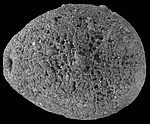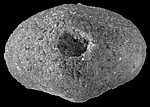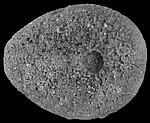Corystusidae
Foster & Philip, 1978, p.792
syn.
Corystidae Foster & Philip,1978, p.792 non corystidae Samouelle, 1819 (Crustacea) ICZN opinion 2238 (12/2009)
case 3419 : The Commission has ruled that the homonymy between the family-group names CORYSTIDAE Foster & Philip, 1978 (Echinodermata, Echinoidea) and CORYSTIDAE Samouelle, 1819 (Crustacea, Brachyura) be removed by adopting Corystus- as the stem of the name of the type genus Corystus Pomel, 1883, giving the corresponding echinoderm family-group name CORYSTUSIDAE.
Genre type : Corystus Pomel, 1883
Description succinte de la famille : Plaques épisternales placées symétriquement et en arrière de la plaque sternale. Elles sont suivies par une plaque rostrale isolée. Fasciole sous anal entourant cette dernière.

diagnose originale du genre par Pomel,1883
Classification méthodique et genera des échinides vivants et fossiles, p.61
|
Corystus Pom. apex allongé par intercallation des ocellaires paires antérieures etre les deux paires de génitales. Ambulacre antérieur logé dans un faible sillon ayant des pores plus petits que les ambulacres pairs. Dessous déprimé avec un grand péristome pourvu de phyllodes et de bourrelets ; le périprocte est petit, transversal sur une faible dépression. Le type est R. dysasteroïdes duncan, du tertiaire d'Australie ; Rhynch. cariboearum, d'après les dessins de Lovén, parait avoir le même apex et serait peut-être à inscrire au même genre. |
![]()
diagnose originale de l'espèce par Duncan,1877
On the Echinodermata of the Australian Cainozoic (Tertiary) Deposits, p.49
|
PETALOSTICHA. Family NUCLEOLIDAE. Rhynchopygus dysasteroides. sp. nov. Plate III. figs. 9 & 10. The outline of the ambitus from the actinal surface is ovoid, being rounded and broad anteriorly and narrower and slightly pointed posteriorly. This outline is less evident from the abactinal surface on account of the keel which passes from the vertex posteriorly, and of the slight roundness of the test on either sicle of it near the ambitus. The test is thick in substance, and in general shape is rather depressed, but convex above and concave below. It is arched from the front to behind the apical system, which is slightly eccentric to the front, but is slightly flattened anteriorly, and to a certain extent laterally above the ambitus. The arched shape is not so decided posteriorly, where, near the vertex, the keel starts obliquely backwards and downwards to overhang, at about one fourth of the height, the small transverse periproct, which has a flat and shallow groove. The greatest width is just behind the antero-lateral ambulacra ; and the mouth and apical system nearly correspond, the first being slightly more anterior than the other. The apical system is elongate ; and the anterior and posterior pairs of generative pores are wide apart, the ocular plates of the antero-lateral ambulacra coming well in between them (Pl. III. fig. 10). Hence the posterior ; lateral ambulacra are more distant than is usual in the Cassidulidze. The anterior generative pores are large, doser together than the posterior ; and the madreporiform body is small, convex, and reaches just in front of the right ocular foramen. Thc posterior pairs of generativo pores are vider apart and slightly smallcr than the anterior, and are posterior (by the length of their own distance apart) to the ocular foramina of the antero-lateral ambulacra. The rectangular space between the anterior and posterior generative pores is slightly depressed, the madreporic body formiiig however an elevation in it. This space is covered with miliaries and a few small tubercles. The ambulacra are long and narrow, being, with the exception of the anterior, which is slightly in a groove, flush with the test. The poriferous zones are lower, and are continued th the ambitus, the distance between the pairs of porcs gradually increasing near the edge. The poriferous zones are narrow, and not so wide as the interporiferous ; and the pores of the inner rows are round and smaller than the oval and more or less elongate kinds of the outer rows. They are conjugate. Thc pores of the odd anterior ambulacrum are less developed than the others ; and those of the inner or posterior zones of the lateral posterior ambulacra are few in number towards the ambitus, to which, however, they extend. The ocular pores are well developed, and a miliary granulation covers the test between all the pores and the interporiferous areas, a few scattered tertiary tubercles being there also. The tuberculation is small, and tubercles of the third order are the largest on the uppér surface. They increase in n_umber towards the ambitus, and are surrounded by a sunken scrobicule surrounded by miliaries. The keel is distinct, slightly angular, and reaches backwards so as nearly to overhang the ambitus. The concave actinal surface has a large sunken mouth, a plain band reaching from it posteriorly, and a distinct tubereulation at the edge of the test. Length of specimen1 9/10 inch, breadth 1 8/10, height 6/10. Locality. No. 5 Upper Coralline Beds, Castie Cove, near Cape 0tway. The resembla.nce of this species to Rhynchopygus pacificus, Ag. (Rev. Ech. Part i. p. 153 and Part iii. p. 554), is very decided in some points ; but it differs from it and from the species from the Caribbean Sea by having an elongated apical system, and in the separated apical ends of the lateral and posterior 1)4- airs of ambulacra. This Dysasterian peculiarity resembles that of Hyboclypus, which may be said to be a Galerites with an elongated apical system, thus uniting this last genus to Ananchytes. The Australian Lower Cainozoic Rhynchopygus is unlike ail the other species of the genus in this special peculiarity. The genus is represented in the Gault, in the uppermost Cretaceous rocks, and in the Tertiary tuff of Guadeloupe ; and the recent forms are from the Caribbean and the Pacific toast of America. moere it not for the strong generic resemblance of the new species, the nature of the curious and suggestive apical system might determine the formation of a new genus ; but it is perhaps most advisable to retain the form where it is plaeed, so as to make it a passage species from one great group to another. plache III (extrait) |
|
Corystus dysasteroides (Duncan,1877) - Miocène inférieur, Mannum Fm, Murraylands, Australie du Sud, 61 mm |

diagnose originale du genre par Foster & Philip (extrait/abstract)
Tertiary holasteroid echinoids from Australia and New Zealand, 1978, p.798
|
Genus cardabia gen. nov. Name. From Carbabia Creek, Carnarvon Basin, Western Australia. The name is pronounced 'card-ah-buyer', with emphasis on 'buy'. Type species. Cardabia bullarensis sp. nov. Diagnosis. Small corystids lacking a frontal notch and with a flat upper surface relatively densely tuberculated. There are three genital pores. Remarks. This new genus is clearly related to Corystus through the presence of a rostral plate. However, the earlier Cardabia, with three genital pores, can hardly have given rise to Corystus with four. As Cardabia had populated the Australian and Antarctica, their common ancestor must be sought in the pre-Palaeocene Indian Ocean. |
![]()
diagnose originale de l'espèce par Foster & Philip (extrait/abstract)
Tertiary holasteroid echinoids from Australia and New Zealand, 1978, p.798
|
Cardabia bullarensis sp. nov. Plate 90, figs. 3, 4 ; Plate 91, figs. 1-3 Material and occurrence. Twenty-three specimens from the northern en of Giralia Anticlin, Carnarvon Basin on Giralia Station, North West Division, Western Australia. Nine, including the holotype (WAM 73.361) and two paratypes (WAM 73.365, 73.366) are from the south side of the Bullara-Giralia road in the vicinity of the turn-off to Jubilee Bore at approximatly 22° 40' S., 114°, 13' E., and about 6.5 km south of the bore. Although the echinoids were not found in situ they have traces of white glauconitic lime mudstone adhering to them. Eleven reddish silicified specimens were found loose 400 m south of a white hill about 5 km south of Jubilee Bore at approximately 22° 39' S., 114° 14' E. NMV P31199 was collected by T. A. Darragh and labelled 'Wadera Calcarenite, float on E. side of Main N.-S. tract of C-Y Creek (due E. of bore and E. of fence, Open Country Paddock), Yanrey 188147', at approximately 22° 52' S., 114° 7' E. A further two crushed echinoids( P31227, 31228) are probably the same species. They are from the type section of the Wadera Calcarenite, Old Marilla Station at 22° 50' S., 114° 8' E. Measurements. The dimensions of the holotype are : length 20 mm, width 17 mm, height 10 mm. Other specimens from the same locality range from 14 x 11 x8 mm up to 25 x 21 x 11 mm. Description. Adapical and adoral surfaces flattened, with the ambitus uniformly rounded. Prominent plastronal keel which terminates in a slight anal rostrum ; anterior margin gently rounded at the ambitus. Apical system in front of centre, disjunct, with three genital pores ; that of the madreporiste is lacking. Ambulacra composed of small pore-pairs not easily discernible in unweathered specimens. Adapically the small round pores are placed close together and separated by a granule. The pore-pairs in the paired ambulacra placed slightly en-chevron ; in ambulacrum III they are almost longitudinally directed. Transversely oval periproct located just above anal rostrum. Subcircular, anteriorly located peristome with prominent phyllodes composed of deeptly countersunk pores. Test coated with coarse granules and relatively dense small primary tubercles. Adoral surface with dense plastronal tuberculation but tubercles absent in the phyllodes and ambulacra I and V. Plastronal plating consisting of a relatively long labrum extending to the second ambulacral plate followed by a single large sternal plate extending to the fourth ambulacral plate. There follows a pair of episternal plates (the suture which separates them is only discernible with difficulty in the available material). The episternals are succeeded by a single plate, in the position of the point of the rostrum, and then two pairs of pre-anals. A subcircular subanal fasciole encloses the rostral plate. Remarks. This new species is readily distinguished from specimens of Corystus dysasteroides in the Australian Tertiary by its smaller size, three genital pores, flat upper and lower surfaces, less prominent pore-pairs arranged en-chevron, subcircular peristome, coarser and more dense tuberculation, and the absenc of a frontal notch.
|
|
Cardabia bullarensis Foster & Philip, 1978 - Paléocène, Girala, Australie, 22 mm |
|
Cardabia bullarensis Foster & Philip, 1978 - Paléocène, Calcarénite de Wadera, Australie, 17 mm |

,%20apical,%20miocene%20inferieur,%20mannum%20formation,%20murraylands,%20australie%20du%20sud,%20australie,%2061%20mm.jpg)
,%20detapical,%20miocene%20inferieur,%20mannum%20formation,%20murraylands,%20australie%20du%20sud,%20australie,%2061%20mm%20copie.jpg)
,%20periprocte,%20miocene%20inferieur,%20mannum%20formation,%20murraylands,%20australie%20du%20sud,%20australie,%2061%20mm.jpg)





